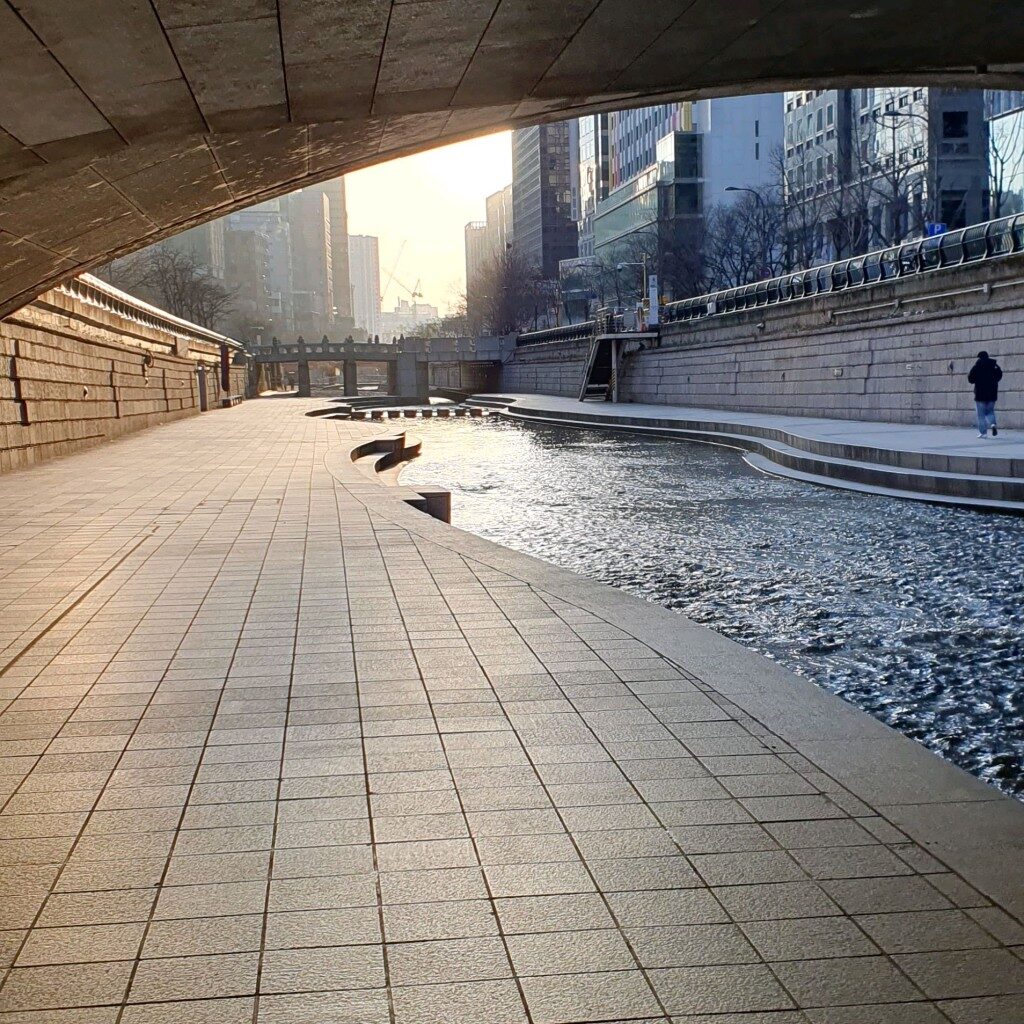Written byLoris Gautier
Posted on10 May 2024
Cheonggyecheon n’est pas seulement un cours d’eau qui traverse Seoul ; c’est un symbole de résilience et de modernité. Cette rivière artificielle, longue de près de 11 kilomètres, qui serpente au cœur de la capitale sud-coréenne, offre un havre de paix loin de l’agitation urbaine. Restaurée et réouverte au public en 2005 après des décennies passées sous une autoroute, elle est désormais un des attraits majeurs de la ville, riche de son histoire, de sa culture et de ses activités variées.

Cheonggyecheon est un exemple frappant de la transformation urbaine. Originairement un cours d’eau naturel, la rivière a été progressivement recouverte durant les années 1950 et 1960 pour faire place à des infrastructures routières, répondant à l’expansion rapide de la ville et à l’augmentation du trafic. Ce n’est qu’au début des années 2000 que le gouvernement de Séoul a initié un ambitieux projet de restauration visant à rétablir le cours d’eau dans sa forme originelle comme partie intégrante d’un vaste programme de revitalisation urbaine.
Ce projet de renaturation, qui a coûté plus de 900 millions de dollars, a non seulement permis de redonner vie à la rivière mais a également transformé les quartiers adjacents en zones piétonnes très prisées des habitants comme des touristes. L’histoire de Cheonggyecheon est un témoignage de la capacité de Séoul à marier conservation du patrimoine et innovation urbaine.
Walks and Relaxation : La promenade le long de Cheonggyecheon est une activité incontournable pour qui visite Séoul. Bordée de voies piétonnes et ponctuée de plus de vingt ponts, elle offre un parcours agréable et accessible pour tous. Les visiteurs peuvent admirer les œuvres d’art public, les murs de cascades et les jets d’eau, qui animent le parcours tout au long de l’année.
Cultural Events and Festivals Cheonggyecheon: Cheonggyecheon is the scene of many cultural events, especially during traditional festivals such as the Seoul Lantern Festival, when thousands of lanterns light up the river, creating a magical spectacle.
To discover the Cheonggyecheon, there's nothing better than to start at the river's starting point, near the square. Gwanghwamun, et de suivre son cours jusqu’à son embouchure dans le Han River. This itinerary allows you to discover different aspects of Seoul, from its historic districts to its modern areas.
From Gwanghwamun to Dongdaemun : Cette section de la promenade traverse plusieurs quartiers historiques et offre des vues imprenables sur des sites historiques, comme le palais de Gyeongbokgung et l’Insa-dong, célèbre pour ses galeries d’art et ses boutiques d’antiquités.
From Dongdaemun to Majang-dong : Poursuivant vers l’est, la promenade devient plus tranquille. Les visiteurs peuvent y découvrir le marché de Majang, réputé pour sa viande fraîche et ses fruits de mer.
Dongdaemun Market : Situé à proximité immédiate de Cheonggyecheon, Dongdaemun est le plus grand marché de textiles en Asie. C’est un paradis pour les amateurs de shopping, offrant une variété impressionnante de vêtements, de bijoux et d’accessoires.
Le Musée d’Art de Séoul : Ce musée, situé non loin de la source de Cheonggyecheon, est un incontournable pour les amateurs d’art contemporain. Ses expositions temporaires et permanentes mettent en avant tant des artistes coréens que internationaux.
Gyeongbokgung Palace : Bien que légèrement en retrait du cours de Cheonggyecheon, ce palais historique est facilement accessible depuis la rivière et offre un aperçu fascinant de l’architecture et de l’histoire de la Corée.
Cheonggyecheon est une véritable artère de vie qui traverse le cœur de Séoul, offrant aux habitants et aux visiteurs un espace unique où nature et urbanisme coexistent harmonieusement. Ce projet de restauration exemplaire a non seulement revitalisé une zone autrefois négligée de la ville mais a également servi de modèle pour des initiatives similaires à travers le monde, démontrant l’impact positif du développement urbain durable.
Did you like our article?
N’hésite pas à t’abonner à notre newsletter gratuite et sans spam !
Korea Exploration est attaché à vous donnés les vrais avis des locaux, d’après Naver voici les avis traduits :
A pleasant last weekend in April~!! 😄
There are a lot of people out~ 😄
Families also take time to enjoy everyday life and create memories~ 😆
📸📸🏝🏝 🏖🏖 🏞🏞
(Foreign tourists from various countries are also busy taking souvenir photos~^^)
Morning visit to Cheonggye Square,
The trail is well laid out, and walking around while admiring the scenery is really rejuvenating ^^.
It rained late into the night,
So on my way out, I took a walk and got some fresh air!
If the weather had been fine, it would have been very busy.
and I probably wouldn't have been able to see well or take many photos.
But time and the hour were on my side,
and I really enjoyed my visit!